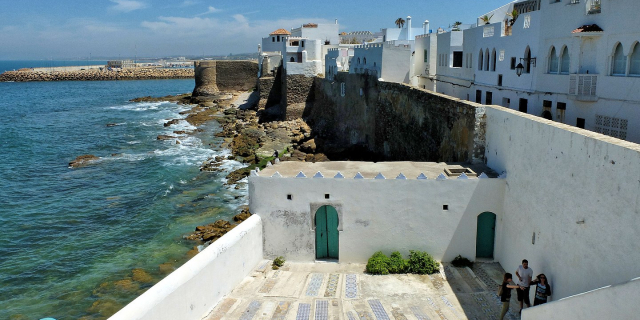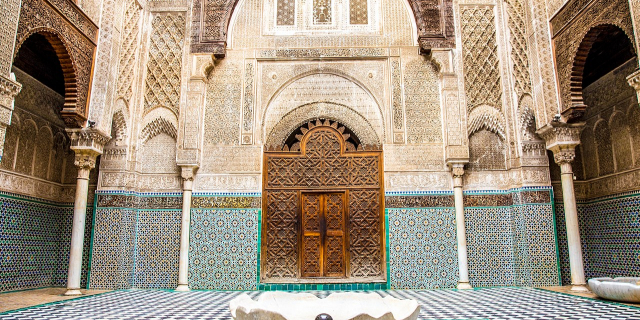شفشاون
( Chefchaouen )Chefchaouen (Arabic: شفشاون, romanized: Shafshāwan, IPA: [ʃafˈʃaːwan]), also known as Chaouen, is a city in northwest Morocco. It is the chief town of the province of the same name and is noted for its buildings in shades of blue, for which it is nicknamed the "Blue City". It is situated in a mountainous region in northern Morocco, between Tétouan and Ouazzane.
It was founded as a military base in 1471, shortly before the Spanish conquest of Granada, and its population grew quickly with Muslim and Jewish refugees fleeing from Spain. Local culture has been influenced by the mixture of Andalusi and Ghomara people. The old walled city, or medina, is still well-preserved alongside a more modern townscape outside its walls. The economy is characterized by artisanal Berber crafts and tourism.
...Read moreChefchaouen (Arabic: شفشاون, romanized: Shafshāwan, IPA: [ʃafˈʃaːwan]), also known as Chaouen, is a city in northwest Morocco. It is the chief town of the province of the same name and is noted for its buildings in shades of blue, for which it is nicknamed the "Blue City". It is situated in a mountainous region in northern Morocco, between Tétouan and Ouazzane.
It was founded as a military base in 1471, shortly before the Spanish conquest of Granada, and its population grew quickly with Muslim and Jewish refugees fleeing from Spain. Local culture has been influenced by the mixture of Andalusi and Ghomara people. The old walled city, or medina, is still well-preserved alongside a more modern townscape outside its walls. The economy is characterized by artisanal Berber crafts and tourism.
The city was founded in 1471 (876 AH)[1] as a small kasbah by Ali ibn Rashid al-Alami, a descendant of Abd al-Salam ibn Mashish al-Alami and Idris I. Al-Alami built the kasbah to defend against Portuguese invasions of northern Morocco.[2] Along with the Ghomaras of the region, many Andalusi Muslims, Moriscos and Spanish and Portuguese Jews settled here during and after the Reconquista, when Spanish Christians conquered what remained of al-Andalus, the Muslim-controlled parts of the Iberian Peninsula.[3]
Ali Ben Rashid was born in Gherzoim, a nearby village, c. 1440 (844 AH). He went to Emirate of Granada in 1460 and distinguished himself in battle against Christian forces. He settled in Chefchaouen c. 1465 and, due to his experience as a warrior, was chosen as successor to his cousin ibn Abi Jum'ah and leader of the mujahideen in the northwest of Morocco. He fought alongside the emir of Tétouan, Ali al-Mandri, who married his daughter, the Mujahida Aisha al-Hurra. The latter, known by her title, Sayyida al-Hurra, ruled Chefchaouen through a rapid period of growth and development.[4][5][additional citation(s) needed]
Pressures of the Reconquista and the fall of Granada in 1492 led many of its people to immigrate to Morocco over several centuries. The last Moriscos (descendants of Muslims) were expelled from Spain by Philip III in 1609. Some of these refugees chose to settle in the large cities of Fes, Marrakesh, Tlemcen, Tunis, and Kairouan, while others settled in the jihadist fortress of Chefchaouen, which was in a fierce war against Portuguese armies. They established their quarters on the rugged slopes of the mountains and built their own residential quarters in the Andalusi architectural style, very similar to the traditional quarters of Granada. In a few decades, the fortress of Chefchaouen turned into a prosperous new city, in which the Andalusi-Granadan culture merged with the culture of the Ghomaras. The urban expansion included military fortifications such as walls with about ten gates and the construction of several mosques including the Great Mosque.[4][5][6] The Andalusi community that settled in the city also included several well-known poets and philosophers.[4][additional citation(s) needed]
In October 1920, General Dámaso Berenguer occupied the city for the Spanish protectorate in Morocco.[7] Following the Spanish retreat from the city,[7] Chefchaouen was part of the Republic of the Rif led by Abd el-Krim from 1924 to 1926.[8] In September 1925, in the middle of the Rif War, a rogue squadron of American volunteer pilots, the Lafayette Escadrille, bombarded civilians in the city.[9] Colonel Charles Sweeny had proposed the idea to French Prime Minister Paul Painlevé, who "warmly welcomed the Colonel's request."[10] After el-Krim was defeated with the help of the French, he was deported to Réunion. The Spanish Army retook the city in 1926.[7]
Morocco gained its independence from colonial rule in 1956. Chefchaouen and most of the northern parts of the country were ceded by Spain that year.[11]





































Add new comment